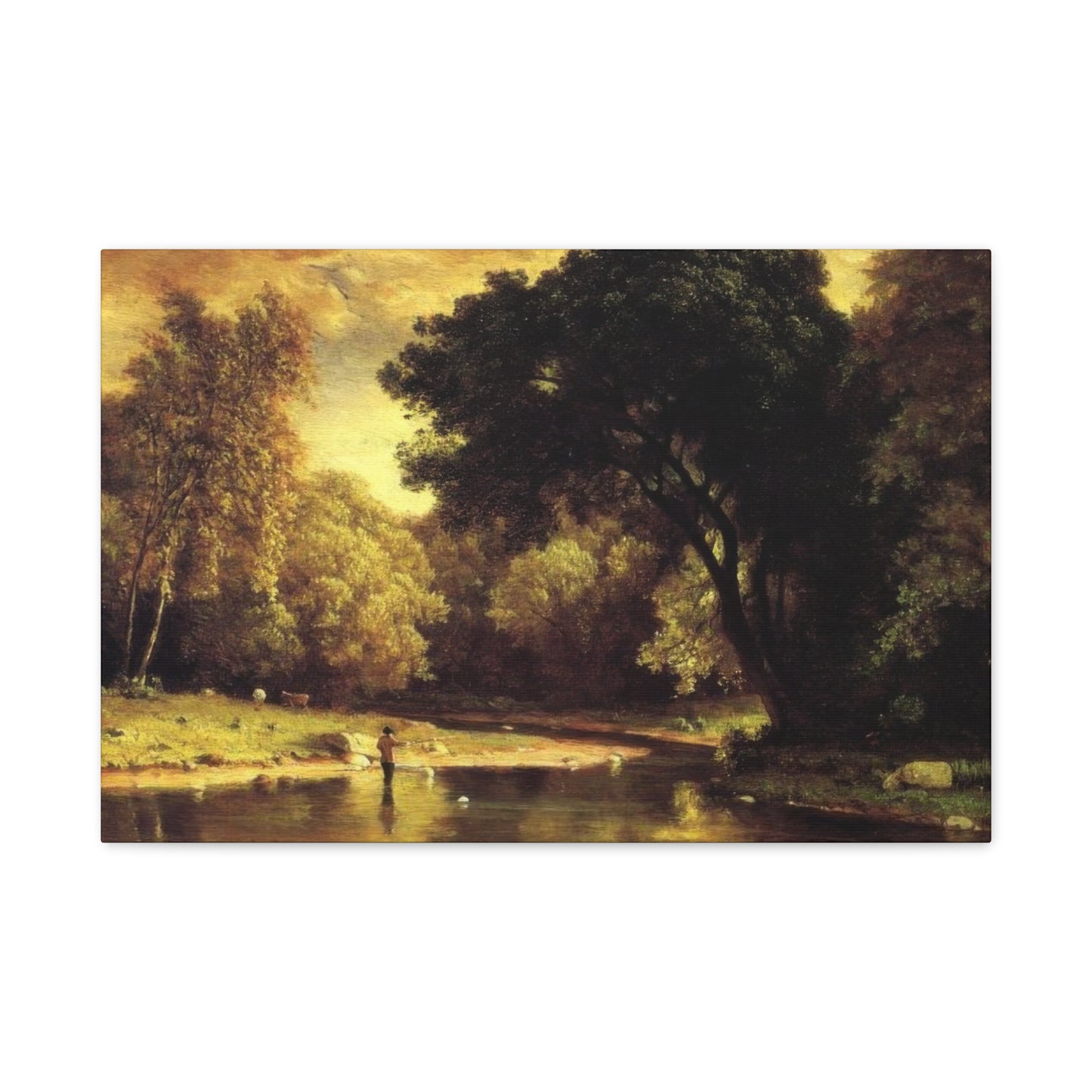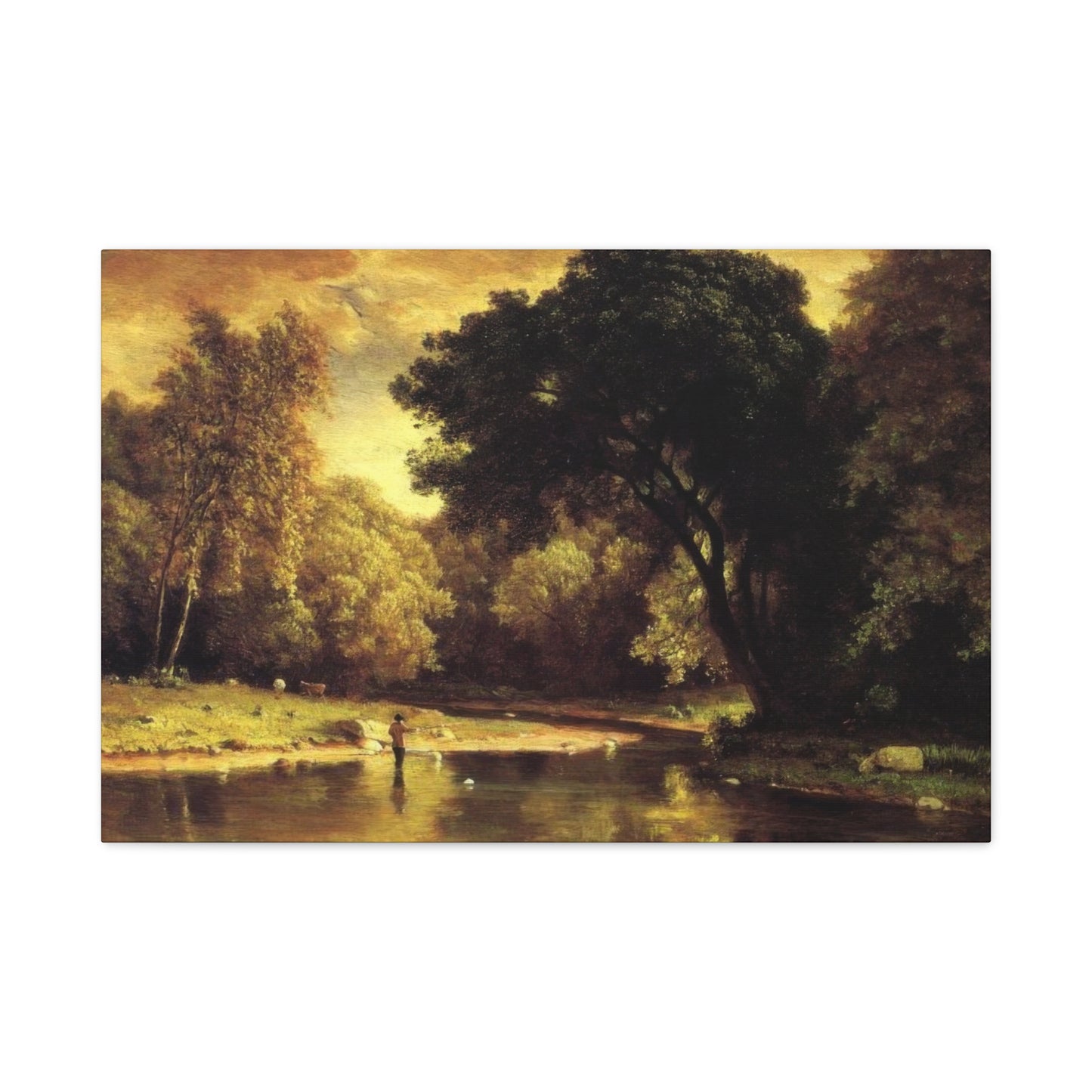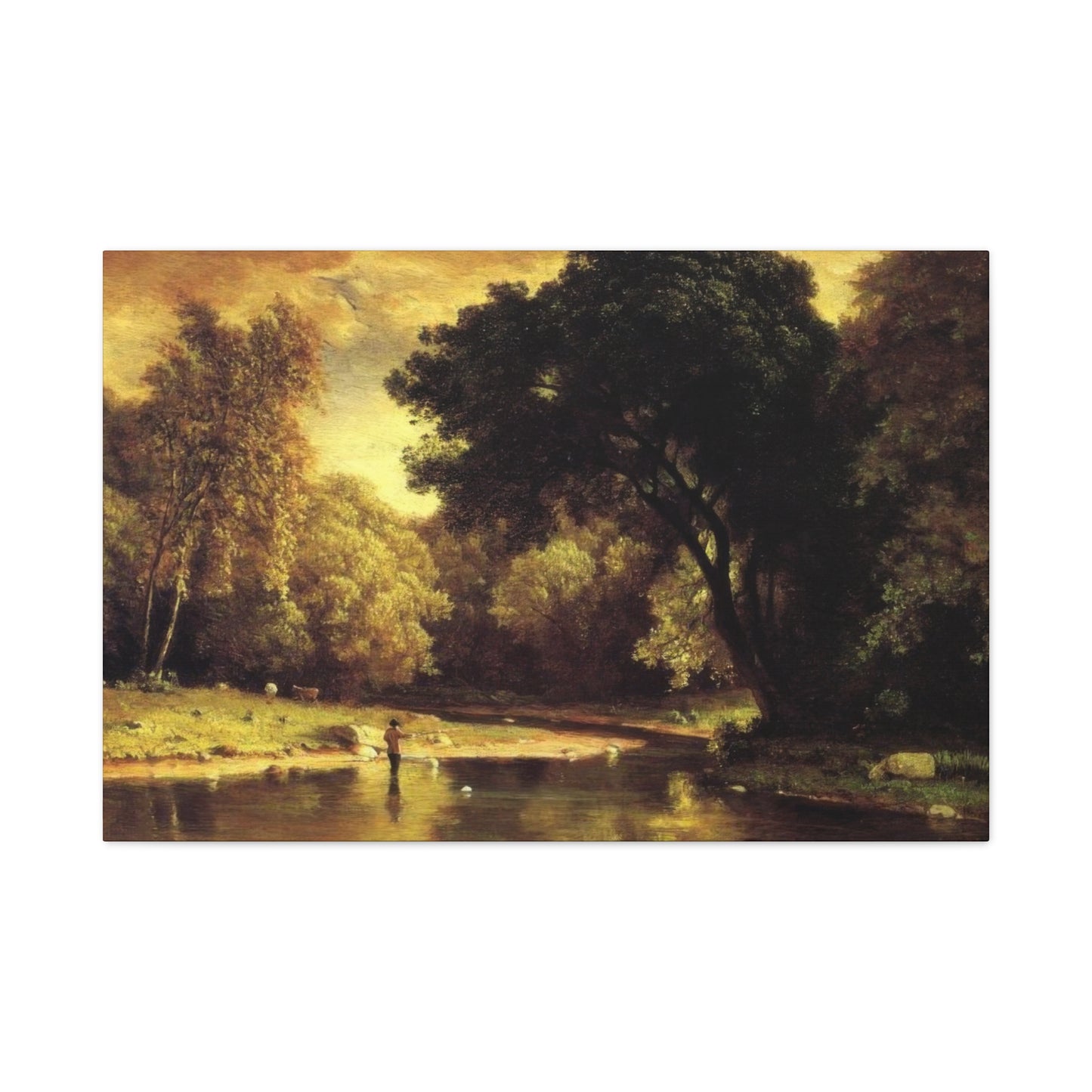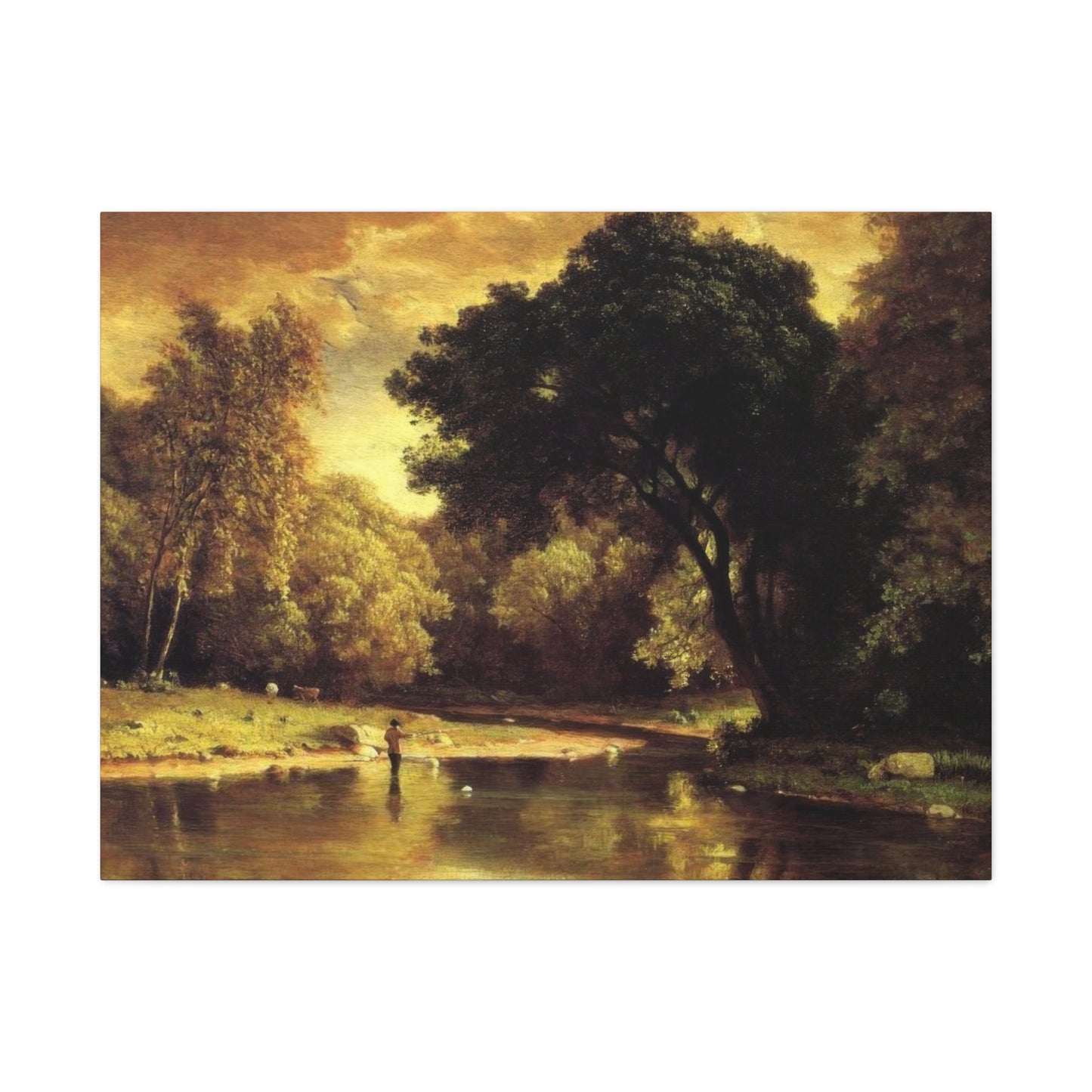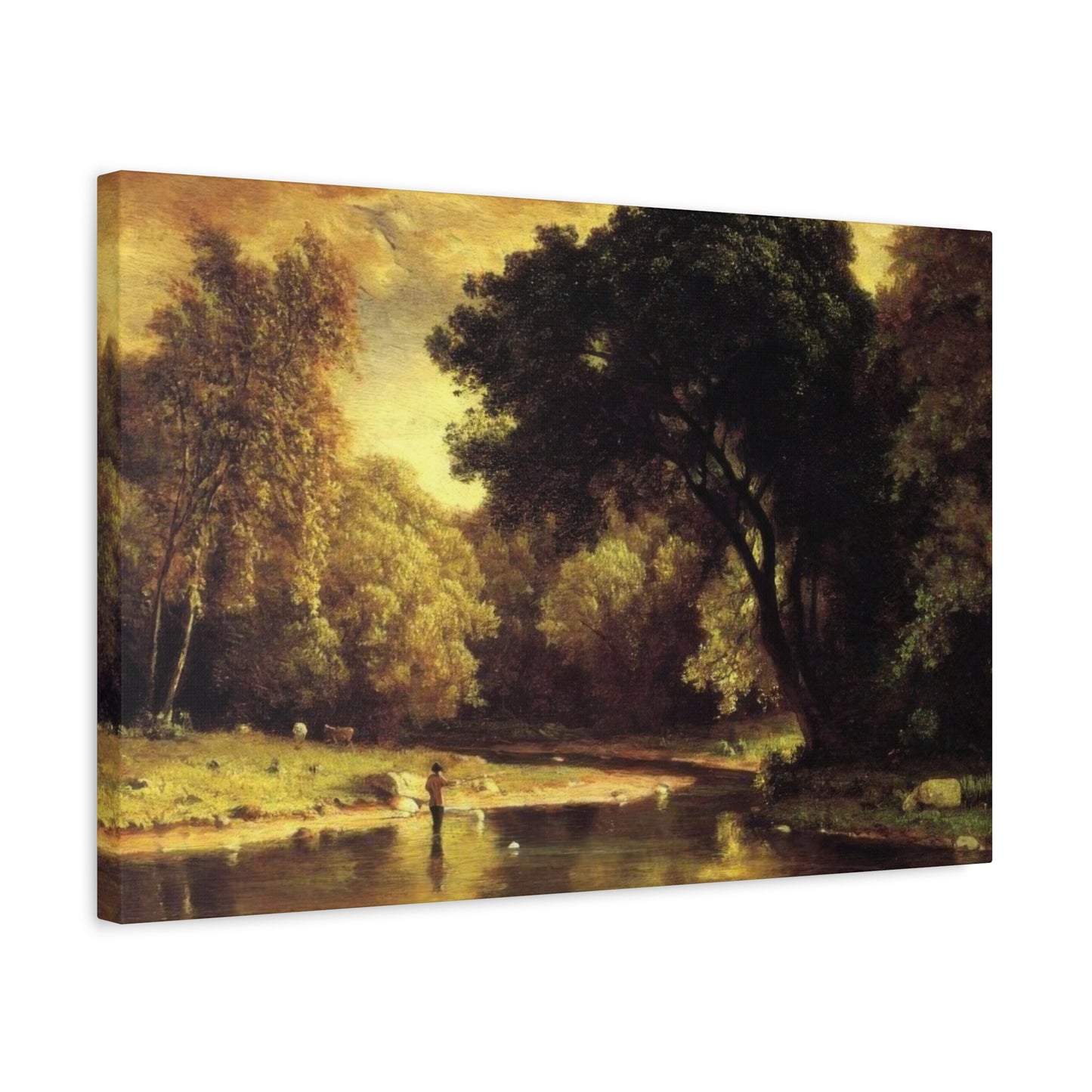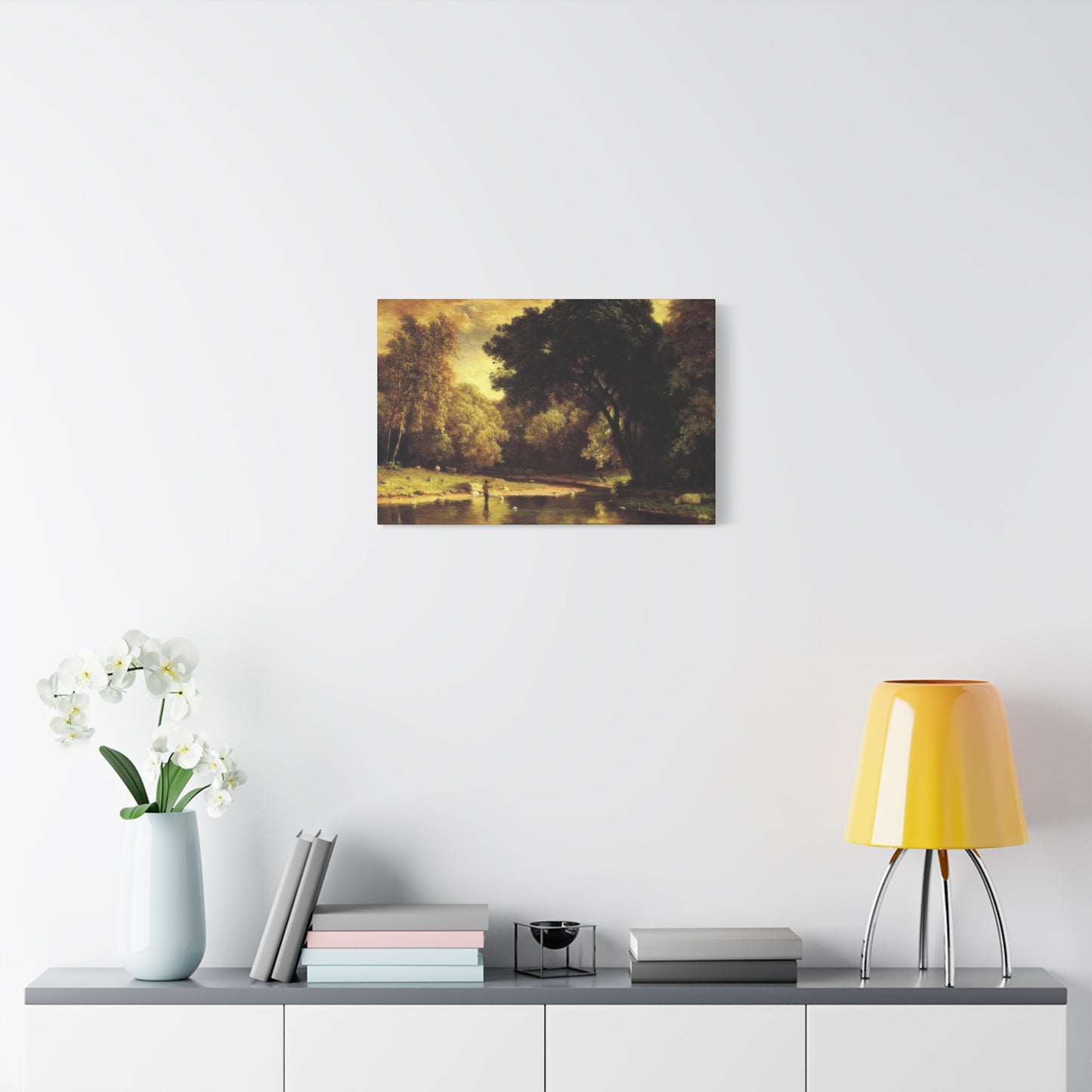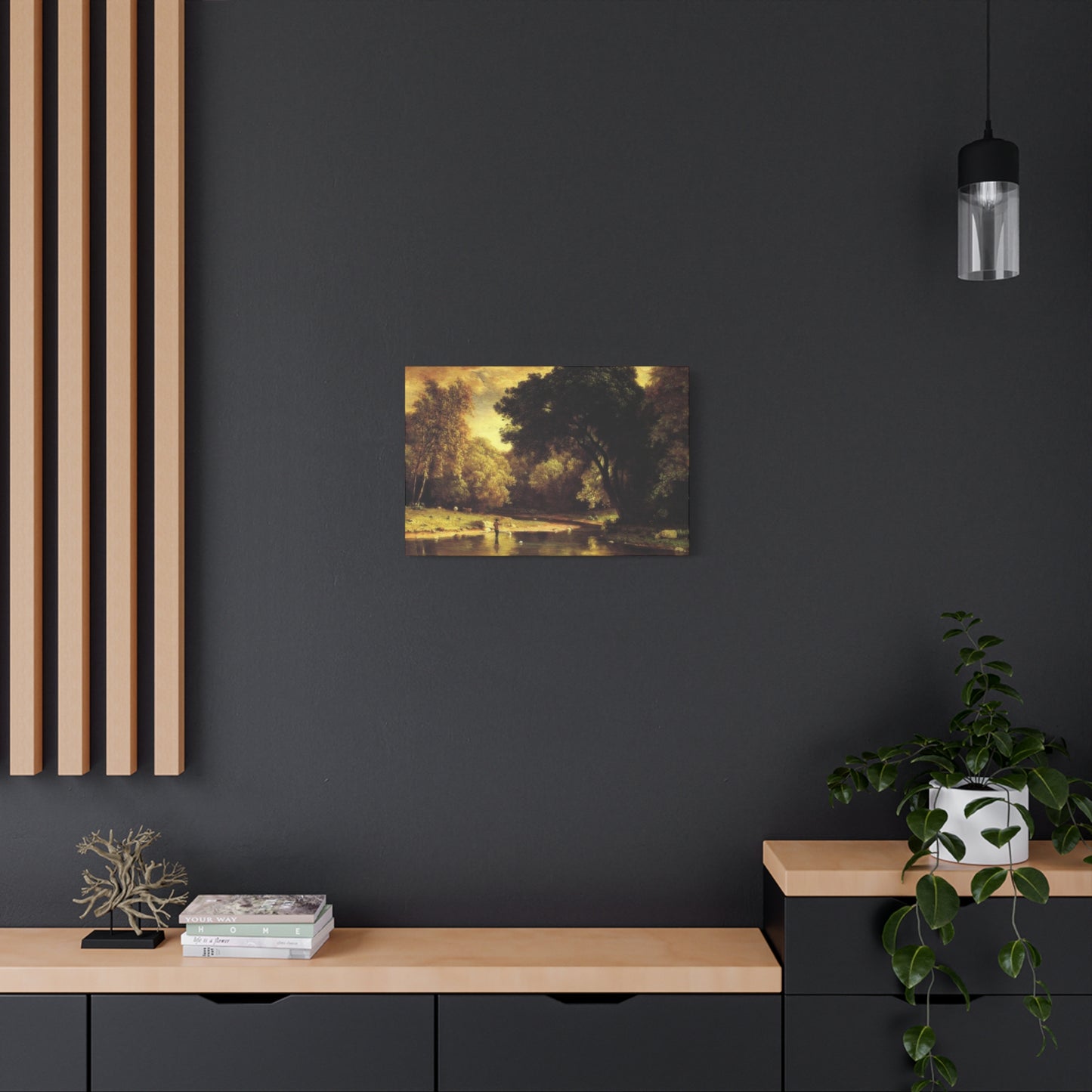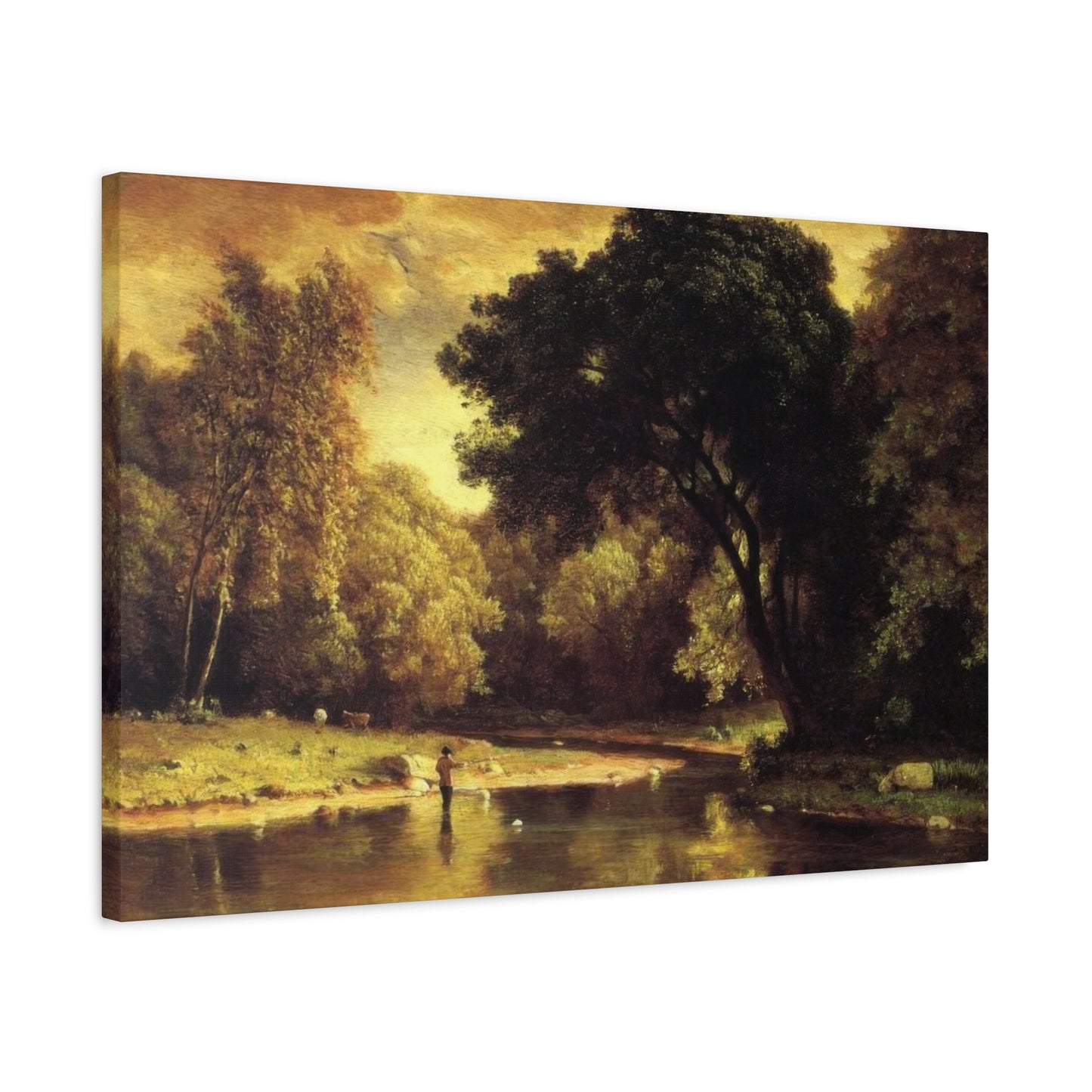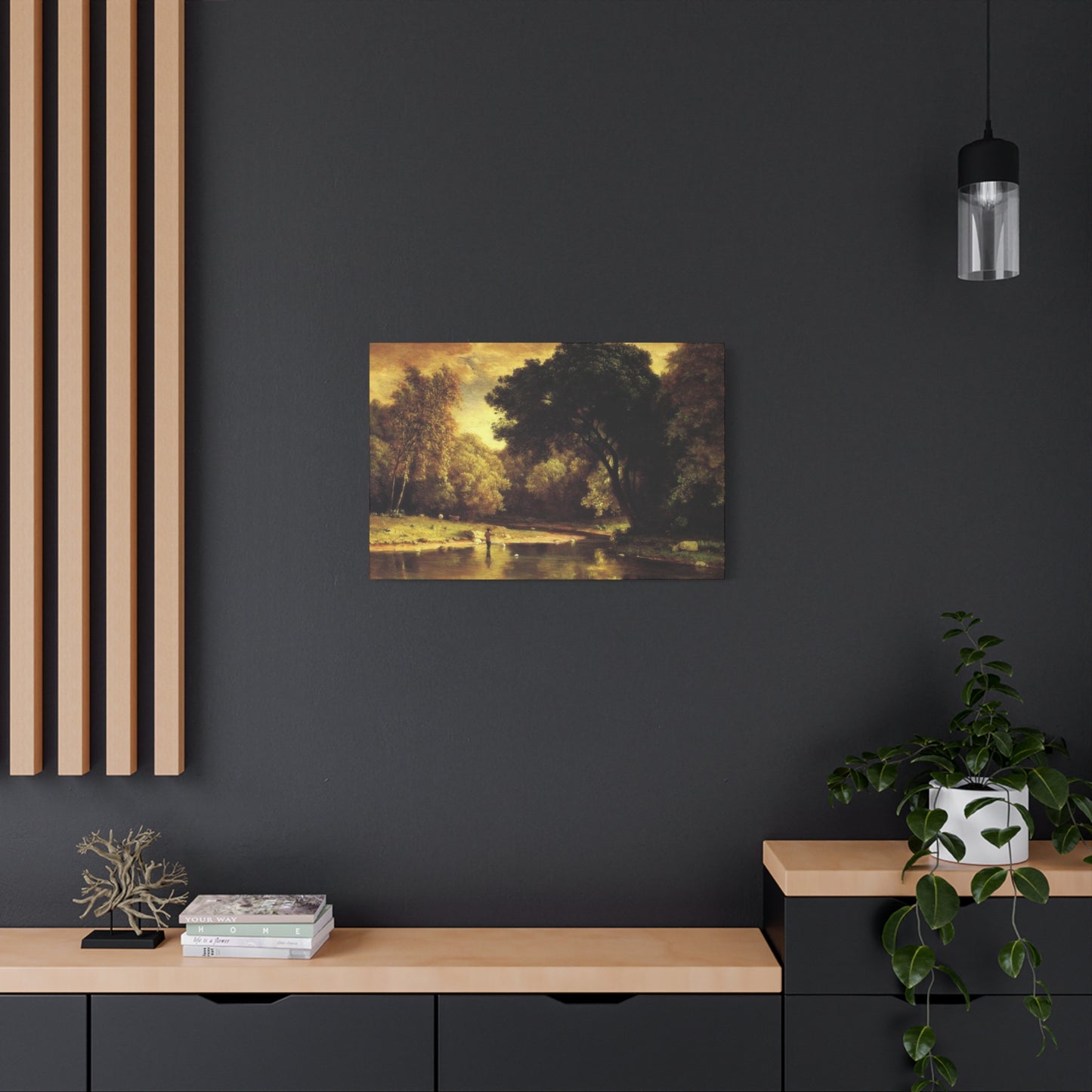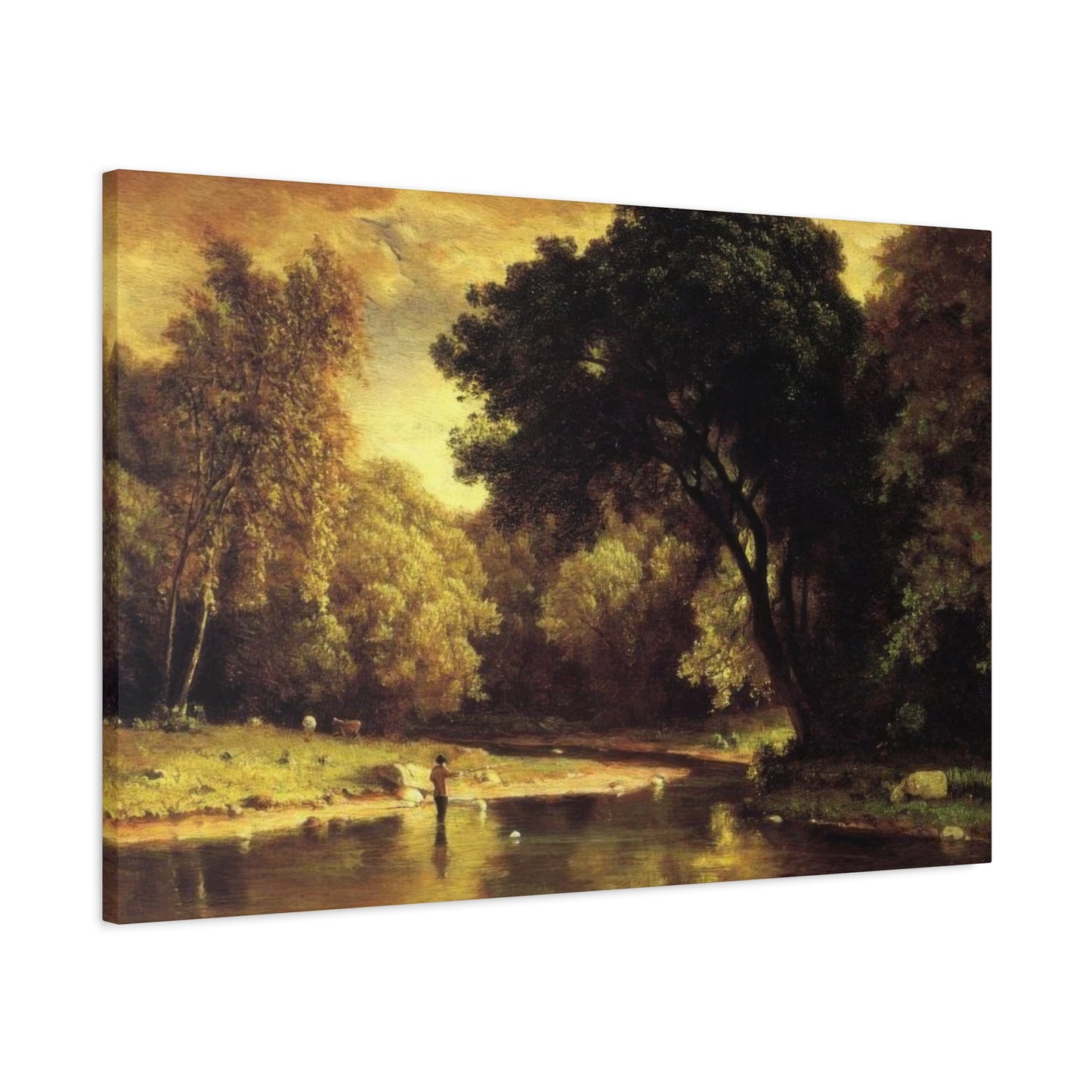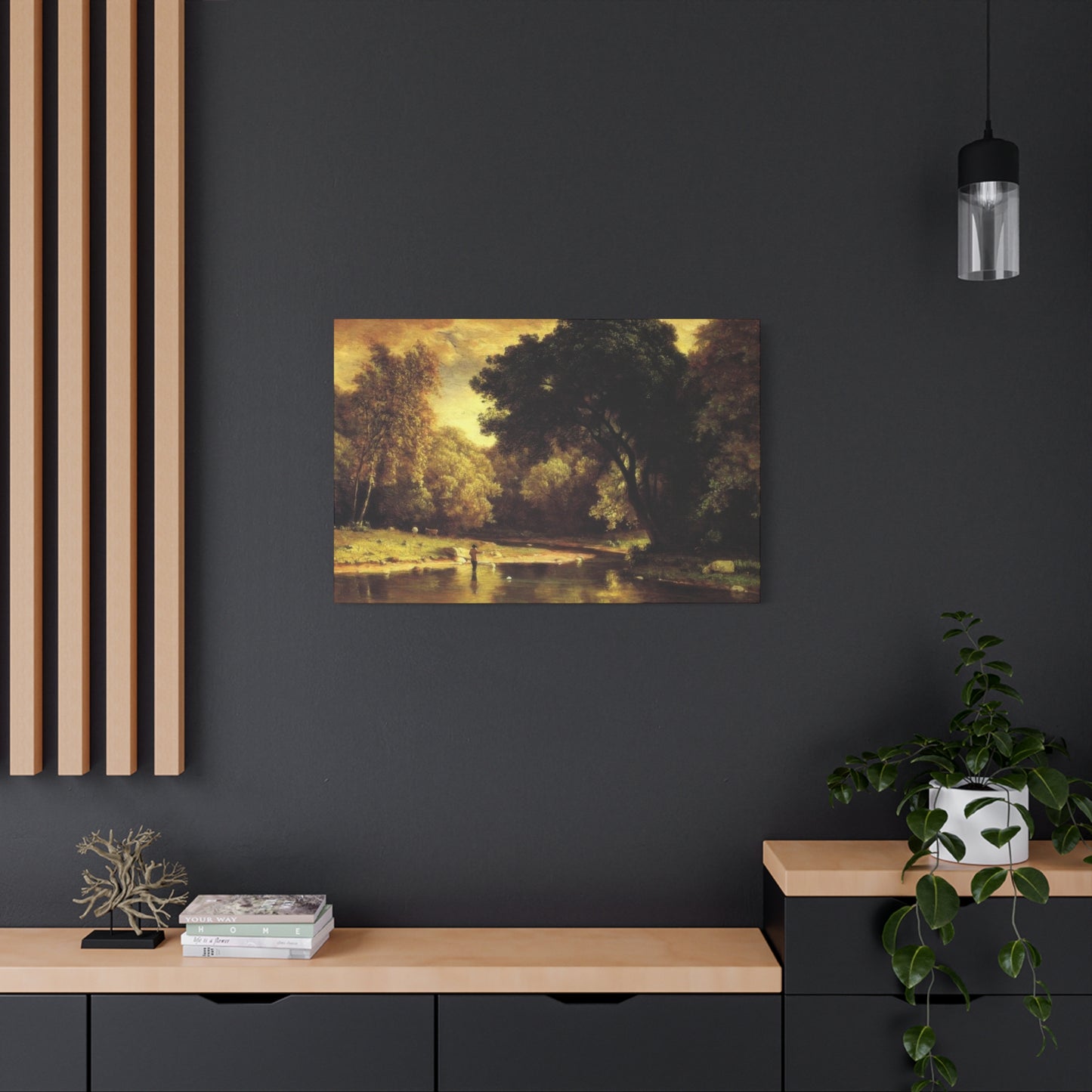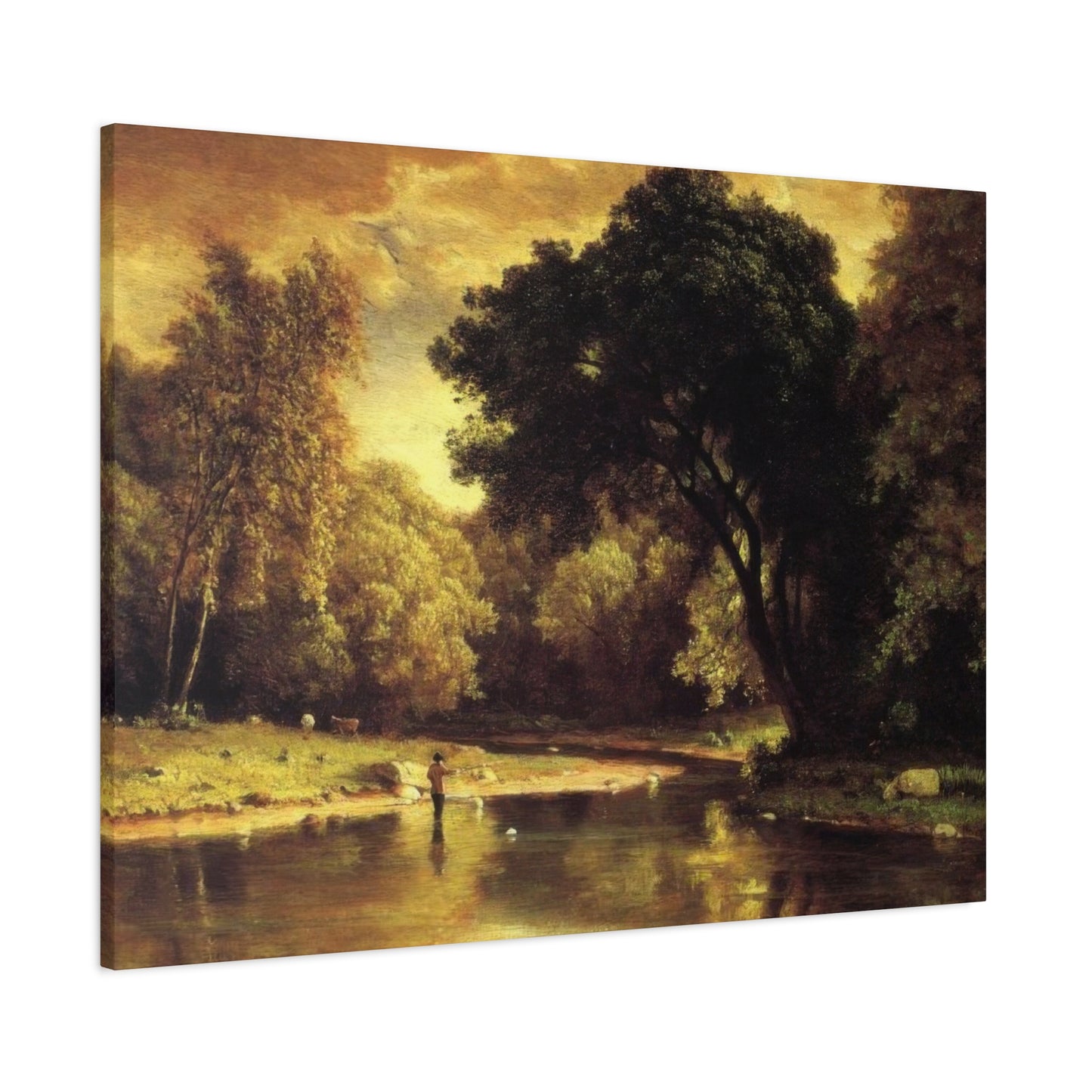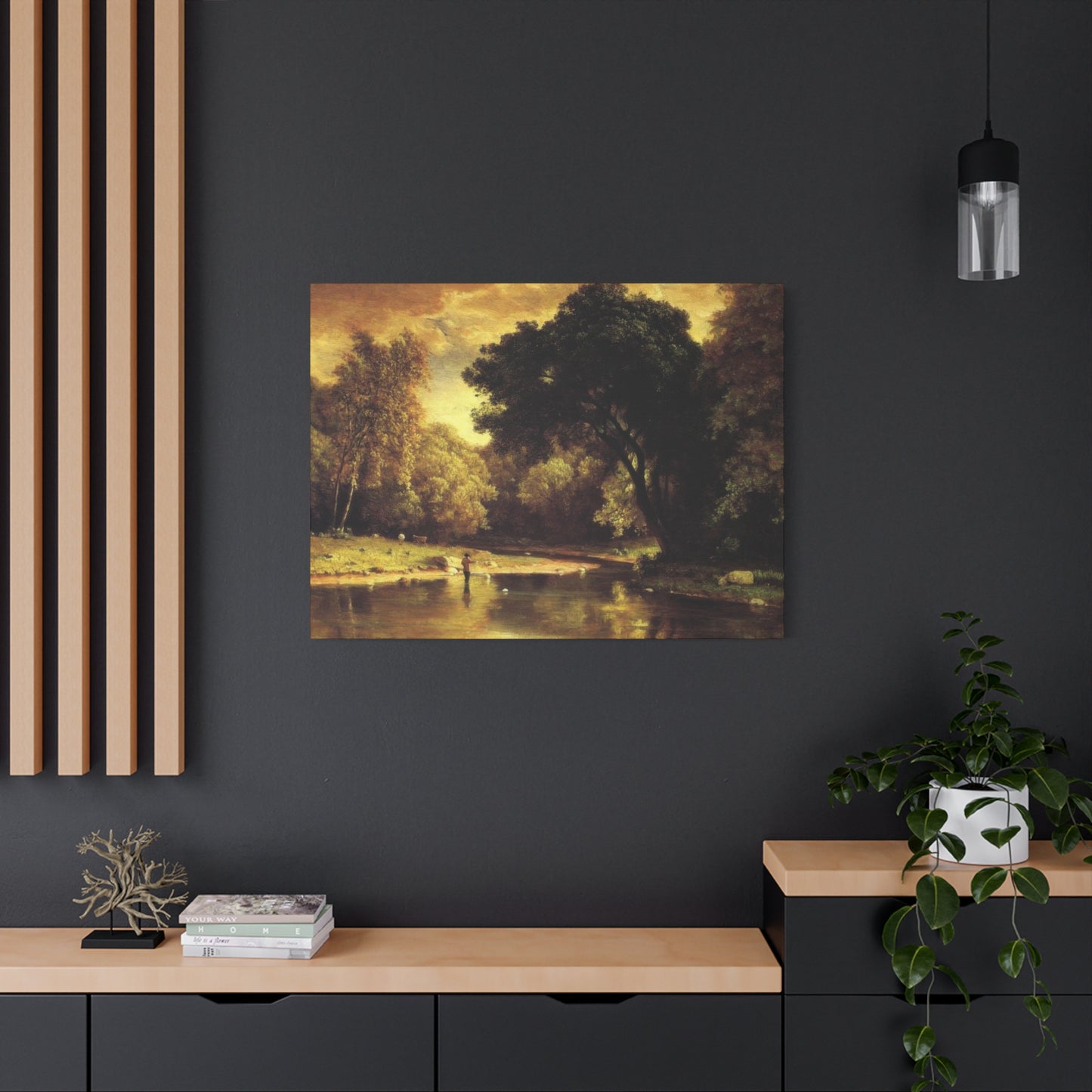The Complete Guide to George Inness Fisherman in a Stream Canvas Wall Art and Landscape Décor
The art of transforming living spaces through carefully selected wall décor has become an essential element of interior design. Among the most cherished and timeless options available to art enthusiasts and homeowners alike are the masterful landscape paintings created during the nineteenth century. These works continue to captivate audiences with their ability to bring natural beauty and tranquility into indoor environments. The fusion of artistic excellence and natural scenery creates an atmosphere of sophistication and calm that resonates with modern sensibilities while honoring classical traditions.
When exploring options for enhancing your home with meaningful artwork, the landscape paintings from this era offer unparalleled depth and emotional resonance. These pieces transport viewers to serene settings where nature unfolds in its most peaceful and contemplative forms. The combination of skilled brushwork, atmospheric effects, and carefully composed natural scenes creates visual experiences that transcend mere decoration. Instead, they become windows into peaceful worlds where the stresses of contemporary life fade away, replaced by the gentle rhythms of flowing water, rustling foliage, and golden sunlight filtering through trees.
The appeal of such artwork extends beyond aesthetic considerations alone. These paintings carry with them the weight of artistic history and the legacy of master painters who dedicated their lives to capturing the essence of the natural world. Each canvas represents not just a scene but a philosophy of seeing, a way of understanding humanity's relationship with the environment. This depth of meaning makes these works particularly valuable for those seeking to create homes that reflect both personal taste and cultural appreciation.
Discovering Tranquility Through Stream and River Scenes on Canvas
The depiction of anglers along quiet waterways has long held a special place in landscape painting traditions. These compositions offer viewers a perfect balance between human presence and natural surroundings, creating narratives that are both relatable and transcendent. The solitary figure engaged in the contemplative act of fishing becomes a stand-in for the viewer, inviting personal reflection and meditation on the simple pleasures found in nature.
Stream and river scenes possess an inherent calming quality that makes them ideal for residential spaces. The horizontal lines of water bodies create visual rest, while the vertical elements of trees and figures provide structure without agitation. This compositional balance mirrors the psychological equilibrium that many people seek in their home environments. The gentle movement suggested by flowing water adds life to a space without introducing the chaos of more dramatic subjects.
The technical execution of water in these paintings demonstrates the highest levels of artistic skill. The interplay of light on moving surfaces, the reflections of surrounding vegetation, and the transparency of shallow stream beds all require careful observation and masterful technique. When successfully rendered, these elements create a sense of realism that draws viewers into the scene, making them feel as though they could step through the canvas into the cool shade beside the water.
Beyond the technical aspects, these scenes carry symbolic weight that resonates across cultures and centuries. Water has always represented life, renewal, and the passage of time. A stream or river in motion becomes a metaphor for life's journey, with all its meandering paths and peaceful interludes. The fisherman becomes a symbol of patience, contemplation, and the human desire to connect with and draw sustenance from the natural world.
Heritage and Excellence in American Landscape Painting
The development of landscape painting in nineteenth-century America represents a pivotal chapter in art history. During this period, artists increasingly turned their attention to the unique character of the American wilderness and countryside. This movement reflected a growing national consciousness and pride in the natural heritage of the young nation. Artists sought to capture not just the physical appearance of the land but its spiritual essence and emotional impact.
This artistic movement emerged during a time of rapid industrialization and westward expansion. As cities grew and wilderness receded, there arose a corresponding desire to preserve and celebrate the natural landscape through art. Painters became chroniclers of a vanishing world, documenting pristine forests, unspoiled rivers, and pastoral farmlands before they disappeared under the advance of progress. Their works served both as celebration and elegy, honoring the beauty of nature while acknowledging its fragility.
The technical approaches developed during this era continue to influence landscape painting today. Artists of this period mastered the challenge of depicting atmospheric effects, creating paintings that captured specific qualities of light and weather. They learned to suggest depth through subtle gradations of color and tone, creating convincing illusions of three-dimensional space on flat canvases. These technical innovations allowed them to create works of remarkable power and presence.
The philosophical underpinnings of this artistic movement drew from various sources, including Romantic ideals about nature's spiritual significance and Transcendentalist beliefs about the divine presence in the natural world. Artists saw their work as more than mere representation; they aimed to convey the emotional and spiritual experiences that nature inspired. This elevated purpose gave their paintings a depth of meaning that purely decorative works could not achieve.
Creating Peaceful Atmospheres with Natural Imagery
The power of landscape artwork to influence the mood and atmosphere of interior spaces cannot be overstated. When thoughtfully selected and properly displayed, these pieces transform rooms into havens of tranquility and reflection. The colors, compositions, and subjects of landscape paintings work together to create emotional responses that affect everyone who enters the space.
Natural imagery in art serves as a bridge between indoor and outdoor environments. For those living in urban settings or climates with harsh weather, landscape paintings provide year-round access to the beauty and peace of nature. They offer visual respite from the hard edges and artificial surfaces that dominate modern built environments. The organic forms and natural color palettes of these works create visual harmony that feels instinctively right to human perception.
The psychological benefits of surrounding yourself with natural imagery have been documented through numerous studies. Viewing scenes of nature reduces stress, lowers blood pressure, and promotes feelings of wellbeing. These effects occur even when the nature is represented through art rather than experienced directly. A well-chosen landscape painting can serve as a daily source of calm and restoration, providing moments of mental escape and renewal throughout the busy day.
The selection of specific natural scenes allows for personalization of these benefits. Water scenes offer particular calming properties, while forest interiors provide feelings of shelter and security. Open meadows suggest freedom and possibility, while mountain vistas inspire awe and perspective. By choosing scenes that resonate with personal experiences and preferences, homeowners can create environments that support their emotional and psychological needs.
Elevating Living Spaces with Classical Artistic Traditions
The incorporation of artwork rooted in classical traditions brings a sense of timelessness and cultural depth to contemporary homes. These pieces connect us to centuries of artistic development and aesthetic philosophy, grounding modern spaces in something larger than current trends. The presence of such work signals an appreciation for enduring quality and a recognition that some forms of beauty transcend temporary fashions.
Classical landscape traditions emphasize careful observation, technical mastery, and compositional balance. These qualities result in works that remain visually satisfying through repeated viewing. Unlike more sensational or trend-driven art, classical landscapes reveal new subtleties each time they are contemplated. This depth ensures that the investment in such pieces pays dividends over years and decades, never becoming tiresome or dated.
The color palettes typical of these traditions tend toward earth tones and natural hues that coordinate effortlessly with a wide range of interior design schemes. The muted greens, warm browns, soft blues, and golden yellows found in traditional landscapes work beautifully with both traditional and contemporary furnishings. This versatility makes these paintings wise choices for homeowners who may evolve their design preferences over time.
The scale and presence of canvas artwork adds significant visual weight to a room. Unlike smaller decorative objects, a substantial canvas commands attention and serves as a focal point around which other design elements can be arranged. The proper placement of such a piece can define the character of an entire room, setting the tone for color choices, furniture selection, and overall aesthetic direction.
Illumination and Atmospheric Beauty in Canvas Art
The rendering of light in painting represents one of the supreme challenges and achievements of the visual arts. Master painters developed sophisticated techniques for capturing the quality of light at different times of day and in various weather conditions. These technical achievements allow paintings to evoke specific moods and temporal experiences with remarkable precision.
Golden light, particularly the warm glow of late afternoon or early morning, holds special appeal in landscape painting. This quality of illumination transforms ordinary scenes into something magical, bathing familiar subjects in a glow that suggests tranquility and timelessness. The technical execution of such lighting effects requires understanding of color theory, atmospheric perspective, and the behavior of light in natural settings.
The interplay between light and shadow creates the sculptural quality that gives painted landscapes their sense of three-dimensional reality. Shadows anchor objects to the ground plane and define their forms, while highlights pick out details and direct the viewer's attention. The subtle gradations between these extremes suggest the complexity of natural lighting and the infinite variety of tones present in any outdoor scene.
Atmospheric effects, including haze, mist, and the softening of distant forms, add depth and mystery to landscape compositions. These effects result from the scattering of light by particles in the air, causing distant objects to appear lighter and less distinct than near ones. Painters who master these phenomena can create convincing illusions of deep space and atmosphere, making relatively small canvases suggest vast expanses of land and sky.
Sophisticated Décor Solutions for Contemporary Interiors
The challenge of decorating contemporary homes often involves balancing modern aesthetics with the desire for warmth and character. Landscape paintings from classical traditions offer an ideal solution to this challenge, providing visual richness and emotional depth without compromising clean, contemporary design principles. These works prove that historical and modern sensibilities need not conflict but can instead complement each other beautifully.
Contemporary interiors often feature neutral color schemes and minimalist furnishings that benefit from the addition of organic, natural imagery. A landscape canvas introduces complexity and visual interest without cluttering or overwhelming the space. The natural subject matter provides a counterpoint to geometric modern forms, while the rectangular format of the canvas echoes the clean lines of contemporary architecture and furniture.
The texture of canvas adds another dimension to contemporary spaces often dominated by smooth surfaces like glass, metal, and painted walls. The subtle weave of the material and the varied texture of paint application create visual and tactile interest that enriches the sensory experience of a room. This physical presence cannot be replicated by prints on paper or digital displays, making original canvas works particularly valuable in high-end interior design.
Gallery-style presentation elevates the impact of canvas artwork in contemporary settings. Simple frames or frameless hanging methods allow the painting itself to take center stage, avoiding the visual competition that can result from ornate framing. This streamlined approach respects both the artwork and the modern aesthetic, creating a harmonious integration that serves both elements well.
Exploring Subtle Techniques in Traditional Landscape Painting
The mastery of landscape painting involves command of numerous technical skills, each contributing to the overall impact of the finished work. Brushwork represents one of the most personal and expressive aspects of painting, serving as a kind of signature that distinguishes one artist from another. The way paint is applied to canvas, whether in smooth, blended strokes or visible, textured marks, profoundly affects both the visual appearance and emotional character of the work.
Subtle brushwork requires years of practice and deep understanding of materials. Painters must know how different brushes behave, how various paint consistencies respond to application, and how colors mix and blend on the canvas surface. This technical knowledge allows them to make split-second decisions during the creative process, responding to the developing image with appropriate techniques that serve the overall vision.
The suggestion of form through economical means represents one of the highest achievements in painting. Rather than laboriously rendering every detail, skilled artists learn to suggest complex forms with a few carefully placed strokes. This approach creates paintings that reward close examination while also reading clearly from a distance. The viewer's eye and mind collaborate to complete the image, engaging with the artwork in an active rather than passive manner.
Atmospheric integration involves ensuring that all elements of a painting exist within a unified space and lighting environment. Objects in the foreground must appear to breathe the same air and receive the same quality of light as those in the distance. This unity requires careful attention to color temperature, value relationships, and the effects of atmosphere on the appearance of objects at various distances. When successfully achieved, this integration creates paintings that feel coherent and believable as representations of real places.
Bringing Rustic Charm into Bedroom Retreats
The bedroom serves as a personal sanctuary where we begin and end each day, making its atmosphere critically important to wellbeing and quality of life. The décor choices made for this intimate space should support relaxation, rest, and peaceful reflection. Landscape artwork depicting tranquil natural scenes provides an ideal focal point for bedroom design, offering visual calm and connection to the natural world.
Rustic themes in bedroom décor create environments that feel grounded, authentic, and removed from the stresses of modern life. Natural materials, earth-tone color schemes, and imagery of countryside or wilderness settings work together to create spaces that encourage unwinding and disconnection from digital distractions. A canvas showing a quiet stream or pastoral landscape reinforces these themes while adding artistic sophistication to the rustic aesthetic.
The psychological transition from wakefulness to sleep benefits from environmental cues that signal safety and peace. Natural imagery provides these cues by depicting settings where humans have traditionally felt secure and at ease. Water sources, sheltering trees, and gentle landscapes all suggest places where basic needs are met and threats are absent. On a subconscious level, these images support the mental shift necessary for restful sleep.
The colors typical of natural landscape paintings align perfectly with recommendations for sleep-supporting bedroom design. Muted greens promote calm, soft blues encourage relaxation, and warm earth tones create feelings of security and comfort. These hues work together to lower arousal levels and prepare the mind and body for rest. Unlike more stimulating colors and subjects, natural landscapes support rather than interfere with the bedroom's primary purpose.
The positioning of artwork in the bedroom requires special consideration. Placing a landscape painting where it can be viewed from the bed provides a focus for meditation or contemplation during quiet moments before sleep or upon waking. This placement turns the artwork into a functional element of the sleep environment rather than mere decoration. The daily engagement with peaceful imagery becomes part of a healthy sleep routine.
Romantic Traditions in Landscape Art for Refined Spaces
The Romantic movement in art emphasized emotion, individual experience, and the sublime qualities of nature. These principles resulted in landscape paintings that sought to evoke powerful feelings and transport viewers beyond the mundane concerns of daily life. The romantic approach to landscape differs from purely documentary representation by prioritizing emotional truth over literal accuracy, seeking to capture the feeling of a place rather than just its appearance.
Romantic landscape traditions celebrate the beauty and power of the natural world while acknowledging human vulnerability and smallness in the face of nature's grandeur. This philosophical stance creates paintings charged with emotion and meaning. The solitary figure in a vast landscape becomes a meditation on existence and consciousness. The dramatic sky or stormy weather symbolizes the turbulence of inner emotional life. These layers of meaning give romantic landscapes their enduring power to move and inspire.
The incorporation of romantic landscape art into refined living spaces adds depth and sophistication that purely decorative elements cannot achieve. These works signal cultural literacy and appreciation for artistic heritage. They demonstrate that the homeowner values substance over superficiality and seeks meaning in their surroundings. This intellectual and emotional dimension elevates the entire character of the space.
The color harmonies and compositional structures of romantic landscapes lend themselves particularly well to formal living areas and spaces designated for conversation and contemplation. The balanced yet dynamic arrangements guide the eye through the composition without causing visual stress. The carefully orchestrated color schemes create unity while offering enough variety to maintain interest. These qualities make romantic landscapes ideal anchors for elegant room designs.
The scale of canvas works in the romantic tradition often tends toward the substantial, reflecting the movement's embrace of grand themes and powerful emotions. These larger formats command attention and create immediate impact upon entering a room. They establish the space as one dedicated to higher pursuits and meaningful experience, setting an elevated tone that influences all subsequent interactions within the environment.
Pastoral Scenes and Their Timeless Appeal
Pastoral imagery in art celebrates the countryside and agricultural life, often idealizing rural existence as more authentic and virtuous than urban living. This tradition extends back centuries, reflecting enduring human ambivalence about civilization and progress. In our current era of unprecedented urbanization and technological advancement, pastoral art resonates powerfully with those seeking balance and connection to simpler ways of life.
The pastoral tradition presents the countryside not as a site of labor and hardship but as a realm of peace, plenty, and harmony between humans and nature. Farmers and shepherds appear as contented figures in benign landscapes where the sun always seems to shine and seasons bring only beauty rather than difficulty. This idealization serves an important psychological function, providing mental refuge from the complexities and anxieties of modern existence.
The compositional elements typical of pastoral scenes include gentle rolling hills, grazing animals, rustic buildings, and figures engaged in simple tasks or leisure. These elements combine to suggest a world in balance, where human needs and natural processes align harmoniously. The absence of discord or conflict in these scenes creates visual environments perfectly suited to spaces designated for relaxation and social harmony.
The color palettes of pastoral landscapes tend toward the lush and verdant, featuring rich greens of grasslands and foliage, golden yellows of ripened grain or sunlight, and soft blues of clear skies. These colors create uplifting, positive environments that support mental and emotional health. The predominance of natural hues ensures easy coordination with various interior design schemes while maintaining a distinctive character.
The universal themes explored in pastoral art make these works accessible to diverse audiences. One need not have direct experience of country life to respond to the appeal of these peaceful scenes. They speak to fundamental human longings for peace, security, and connection to the earth. This broad accessibility, combined with artistic quality, makes pastoral landscapes excellent choices for homes where diverse groups of people gather and interact.
Mastery of Natural Light in Canvas Paintings
The depiction of light represents perhaps the supreme achievement of representational painting. Light makes all vision possible, defines form, creates mood, and changes constantly throughout the day and seasons. Painters who master the representation of light transcend mere documentation to create works that seem to glow with life and presence. This technical mastery separates competent work from truly exceptional achievements in landscape art.
Natural light varies infinitely in quality, color, and intensity. Morning light differs from afternoon light not just in angle but in color temperature and clarity. Overcast days produce even, soft illumination while clear days create strong contrasts between light and shadow. Winter light has a different character than summer light. Master painters observe and internalize these distinctions, allowing them to recreate specific lighting conditions with convincing accuracy.
The warm light of dawn and dusk holds particular appeal for both artists and viewers. These transitional times of day produce lighting that seems magical, transforming ordinary landscapes into scenes of extraordinary beauty. The low angle of the sun creates long shadows and picks out textures invisible at midday. The warm color temperature of the light itself adds emotional warmth to the scene, creating feelings of comfort and contentment.
The technical execution of light effects requires understanding of value relationships and color temperature. Lit surfaces must be rendered in values and hues that sit in correct relationship to shadowed areas. Reflected light must be acknowledged, showing how surfaces bounce illumination to each other. Atmospheric effects must be considered, showing how particles in the air affect the quality and color of light. Each of these factors must be handled correctly for the illusion to succeed.
The emotional power of well-rendered light cannot be overstated. Light gives life to painted scenes, creating the illusion that we are witnessing a particular moment in time. Strong light effects can create drama and excitement, while soft, even lighting promotes calm. Golden light creates nostalgic, dreamlike moods, while harsh light can suggest heat or intensity. Through control of light, painters manipulate viewer emotions with great precision.
Canvas Prints as Investment in Lasting Beauty
The choice between various forms of wall art involves consideration of quality, longevity, and value. Canvas prints combine affordability with substantial presence and durability, making them attractive options for those seeking to enhance their homes with meaningful artwork. Understanding the characteristics and benefits of canvas prints helps buyers make informed decisions that serve their needs and budgets effectively.
Canvas as a material has been the preferred support for serious painting for centuries. Its texture contributes to the character of painted works, and its flexibility allows for creation of large works that would be impractical on rigid supports. When high-quality reproduction techniques transfer painted images to canvas, the resulting prints retain much of the character and presence of original paintings at a fraction of the cost.
Modern printing technologies achieve remarkable fidelity in reproducing the colors, values, and even textures of original paintings. High-resolution digital capture records every nuance of the original work, and sophisticated printing processes translate this information to canvas with impressive accuracy. The resulting prints can capture subtle color gradations and fine details that lesser reproduction methods miss entirely.
The longevity of properly produced canvas prints makes them sound investments in home décor. When printed with archival inks and properly cared for, these works can maintain their visual quality for decades. Unlike posters or paper prints that may fade or deteriorate relatively quickly, quality canvas prints can become long-term fixtures in the home, providing consistent beauty and value over many years.
The substantial physical presence of stretched canvas creates an entirely different experience compared to framed paper prints. The three-dimensional quality of canvas stretched over bars gives the work a sculptural presence in the space. The texture of the material adds visual and tactile interest. The weight and permanence of properly mounted canvas signal quality and seriousness, elevating the perceived value of the work and the space it occupies.
Designing Living Rooms Around Natural Themes
The living room serves as the primary gathering space in most homes, hosting family activities, social occasions, and personal relaxation. The design of this multifunctional space must balance various needs while creating an environment that feels cohesive and intentional. Natural themes in living room design provide a unifying concept that supports multiple functions while creating spaces that feel both welcoming and sophisticated.
Natural themes work beautifully in living rooms because they appeal to universal human responses rather than specific style preferences. Everyone responds positively to well-composed natural imagery and color palettes drawn from the earth and growing things. This universality makes naturally themed spaces comfortable for diverse groups, from family members of different generations to guests with varying tastes and backgrounds.
The color schemes associated with natural themes offer remarkable versatility. Greens range from deep forest hues to bright spring shades, each creating different moods and associations. Browns span from pale sand to rich chocolate, offering grounding and warmth. Blues echo water and sky, adding freshness and calm. These natural colors coordinate effortlessly with each other and with most wood finishes and common upholstery fabrics.
The incorporation of landscape artwork serves as an anchor for natural themes, establishing the conceptual direction of the space. Other design elements can then be selected to support and enhance this theme. Natural fiber textiles, wood furniture, stone or ceramic accessories, and plants all reinforce the connection to nature established by the artwork. The cumulative effect creates spaces that feel organic and harmonious rather than contrived or artificial.
The psychological benefits of naturally themed living spaces extend to all who use them. These environments reduce stress, promote positive social interactions, and support mental restoration. Family members returning home from the demands of work and school find genuine refuge in spaces that echo nature's calming qualities. Guests experience hospitality enhanced by environments that feel open, welcoming, and life-affirming.
Nineteenth Century Artistic Heritage for Modern Homes
The nineteenth century witnessed extraordinary developments in landscape painting, with artists achieving new levels of technical mastery and emotional expression. This period produced a wealth of masterworks that continue to influence artists and inspire viewers more than a century later. The incorporation of works from this heritage into contemporary homes creates connections across time, linking present-day living to artistic traditions of enduring value.
The artistic movements of the nineteenth century reflected and shaped the cultural values of their era while creating works that transcend their original context. These paintings document a world vastly different from our own yet address themes and emotions that remain completely current. The relationship between humanity and nature, the search for meaning and beauty, the desire for peace and connection are all expressed in ways that speak across the centuries.
The technical innovations of nineteenth-century painters laid the groundwork for much that followed in art history. Their experiments with color, light, and composition expanded the possibilities of painting while establishing principles that remain valid today. Study of these works provides insight into fundamental aspects of visual art, making them valuable not just as decoration but as educational resources and inspiration for creative thinking.
The collecting and display of works from this period demonstrates cultural sophistication and historical awareness. These pieces connect personal spaces to broader narratives of artistic development and cultural history. They signal that the homeowner values substance, continuity, and excellence. This messaging enriches the character of the home, making it a place of depth and meaning rather than mere shelter and convenience.
The market for reproductions and prints of nineteenth-century masterworks makes this heritage accessible to broad audiences. One need not be a wealthy collector to enjoy the beauty and meaning of these works. Quality reproductions bring the experience of these paintings into homes at various price points, democratizing access to cultural treasures that were once the exclusive province of museums and the wealthy.
Creating Visual Harmony Through Earth-Toned Palettes
The color palette of a space profoundly affects its mood, apparent temperature, and the emotional responses of those who occupy it. Earth-toned palettes, drawing colors from soil, stone, wood, and vegetation, create environments that feel grounded, natural, and psychologically comfortable. These colors work with rather than against human neurology, tapping into deep-seated associations between particular hues and safety, comfort, and wellbeing.
Earth tones include a vast range of colors, from pale cream and beige through various browns, greens, and even muted oranges and reds. This variety allows for sophisticated color schemes that avoid monotony while maintaining overall harmony. The unity comes not from repetition of identical colors but from relationships between hues that share common undertones and appear together in natural settings.
The neutrality of many earth tones makes them excellent background colors that allow other elements to shine without competition. A wall in soft tan or sage green provides context for artwork, furniture, and accessories without overwhelming them. This supporting role makes earth tones particularly valuable in spaces where multiple focal points must coexist peacefully.
The warming qualities of most earth tones create spaces that feel cozy and inviting. These colors suggest shelter, comfort, and security, making them particularly appropriate for homes and other spaces where people should feel at ease. The psychological association between these colors and natural materials like wood and stone adds to their comforting character, tapping into preferences that may be rooted in evolutionary history.
The coordination of earth-toned color schemes with landscape artwork creates powerful synergies. Paintings depicting natural scenes bring the same colors found in the broader décor into focused artistic expression. This repetition with variation creates visual rhythms that feel satisfying without becoming boring. The artwork both reflects and defines the color story of the space, serving as both inspiration and culmination of the design concept.
Artistic Retreats Within the Home Environment
The concept of creating special spaces within the home dedicated to particular activities or moods has gained increasing attention in recent years. As homes accommodate more functions than ever before, the intentional designation of areas for specific purposes helps maintain boundaries and supports psychological wellbeing. Artistic retreats within the home provide spaces for contemplation, creativity, and mental restoration.
An artistic retreat need not be a separate room; a corner of a bedroom, a section of a home office, or even a thoughtfully arranged hallway can serve this function. The key elements include meaningful artwork, comfortable seating, appropriate lighting, and freedom from distractions. These components combine to create an environment conducive to the kind of focused attention and mental quiet that modern life often disrupts.
The selection of artwork for these spaces carries particular significance. Unlike art chosen primarily for aesthetic appeal or coordination with décor, works displayed in artistic retreats should offer depth for contemplation and personal meaning for the viewer. Landscape paintings serve this purpose exceptionally well, providing subjects complex enough for extended viewing while offering the calming qualities that support meditation and reflection.
The lighting of artistic retreat spaces requires careful consideration. Natural light is ideal when available, connecting the indoor space to the rhythms of the day and weather. When artificial lighting is necessary, sources should provide adequate illumination without glare or harshness. The ability to adjust lighting levels allows the space to adapt to different times of day and different activities, from reading to meditation.
The psychological value of having a designated space for retreat and renewal cannot be overstated. Knowing such a space exists provides comfort even when not in use. The option to withdraw from household activity or work demands into a thoughtfully created environment supports mental health and emotional regulation. Regular use of such spaces can become an important element of self-care routines and stress management practices.
Collecting Artwork for Personal Enrichment
The practice of collecting art offers rewards that extend far beyond the pleasure of living with beautiful objects. Collecting involves learning, making decisions, developing taste, and creating a visual autobiography through selected works. For those new to collecting, landscape paintings offer an accessible entry point, combining broad appeal with enough variety to support meaningful collection development over time.
The journey of building an art collection begins with education. Learning to look at paintings critically, understanding artistic movements and techniques, and developing knowledge of particular artists or periods enriches both the collecting process and the enjoyment of acquired works. This learning component transforms collecting from mere acquisition into an intellectual and aesthetic pursuit that grows more rewarding over time.
The development of personal taste represents another important aspect of collecting. Initial choices may reflect uncertainty or adherence to safe, conventional preferences. As knowledge and confidence grow, collectors become more willing to follow genuine personal preferences even when these diverge from popular opinion. This evolution in taste parallels personal growth, with collection reflecting the collector's developing identity and values.
The curation of a collection involves more than simply acquiring individual pieces. Thoughtful collectors consider how works relate to each other, creating groupings that enhance rather than diminish individual pieces. The display of collected works throughout the home creates a unified aesthetic experience, with each piece contributing to an overall statement about the collector's values and vision.
The financial aspects of collecting warrant consideration, though they should not overwhelm aesthetic and personal factors. Quality reproductions and prints make it possible to assemble meaningful collections without substantial financial investment. For those with larger budgets, original works or limited edition prints offer different satisfactions and potential investment value. Regardless of budget level, the focus should remain on personal meaning and aesthetic quality rather than purely financial considerations.
Harmonizing Décor with Landscape Art Collections
The integration of landscape artwork into existing décor schemes requires careful consideration of multiple factors. Color coordination, scale relationships, style compatibility, and thematic consistency all influence how successfully artwork blends with its surroundings. Thoughtful attention to these elements ensures that paintings enhance rather than conflict with the overall design vision.
Color coordination between artwork and surrounding décor can take several approaches. One method involves echoing colors from the painting throughout the room in textiles, accessories, and other elements. This creates visual unity and makes the artwork feel integrated rather than isolated. Another approach uses the artwork as an accent piece, selecting a painting with colors that contrast with but complement the dominant palette of the room.
Scale relationships deserve careful attention when selecting and placing artwork. A painting too small for its wall appears lost and insignificant, while an oversized piece can overwhelm. The general guideline suggests that artwork should occupy roughly two-thirds to three-quarters the width of the furniture below it, though this can be adjusted based on specific circumstances. The height at which artwork hangs also matters, with center points typically positioned at eye level for optimal viewing.
Style compatibility ensures that artwork feels appropriate to its setting. Traditional landscapes work beautifully in both classic and contemporary interiors, but the framing and presentation method should align with the overall aesthetic. Ornate frames suit formal, traditional spaces, while simple frames or gallery-style hanging works better in contemporary settings. The maturity and restraint of classical landscape paintings allow them to adapt to various contexts with appropriate presentation.
Thematic consistency involves ensuring that the subject matter and mood of artwork align with the function and character of the space. Active, dramatic landscapes might energize a home office or exercise area, while calm, contemplative scenes better suit bedrooms and meditation spaces. Social areas benefit from paintings that invite discussion and convey warmth, while private spaces can accommodate more personal or introspective subjects.
Exploring Variations in Natural Scenery Depictions
The category of landscape painting encompasses enormous variety, from intimate woodland interiors to vast mountain panoramas. Understanding this diversity allows collectors and decorators to select works that precisely match their aesthetic preferences and functional needs. Each type of natural scene carries different associations and creates different atmospheric effects.
Forest scenes provide feelings of shelter and enclosure while celebrating the complexity and abundance of nature. The vertical lines of trees create rhythm and structure, while the filtering of light through canopies adds mystery and magic. Forest interiors can feel either intimate and cozy or mysterious and expansive, depending on the specific treatment and viewpoint chosen by the artist.
Open meadow landscapes suggest freedom, peace, and accessibility. The horizontal emphasis and open sight lines create visual rest and feelings of spaciousness. Meadow scenes often include distant horizons, adding depth and suggesting possibilities beyond the immediate view. The seasonal quality of these landscapes allows for expression of different times of year, from spring freshness to autumn abundance.
Mountain landscapes convey grandeur, permanence, and sublime power. The vertical thrust of peaks creates drama and excitement, while the vast scales involved inspire awe and perspective. Mountain scenes can be either inviting or intimidating, depending on the artist's approach and the specific character of the depicted peaks. These powerful images work well in spaces where impact and presence are desired.
Coastal scenes combine elements of land, sea, and sky in dynamic compositions. The meeting of different elements creates visual interest and symbolic richness. Beaches suggest transition and threshold, while rocky shores imply strength and endurance. The inclusion of sky and water opens compositions to atmospheric effects and creates opportunities for sophisticated color relationships.
River valley landscapes often provide the most complete and balanced natural compositions. These scenes typically include water, vegetation, landforms, and sky, creating variety within unity. The valley format provides natural compositional structure, with the river leading the eye through the space. The combination of elements supports rich storytelling and emotional expression.
Investment in Quality Wall Décor Solutions
The decision to invest in quality wall décor represents commitment to creating environments that support wellbeing and reflect personal values. While inexpensive decorative options certainly exist, quality artwork provides different and more substantial benefits that justify higher initial costs through long-term value and satisfaction.
Quality considerations in canvas artwork begin with the reproduction or printing process. High-resolution capture and sophisticated printing technologies ensure accurate color reproduction and fine detail preservation. Archival inks resist fading and color shifts, maintaining the appearance of the work over decades. These technical factors directly impact both the immediate visual quality and long-term durability of the piece.
The canvas material itself varies considerably in quality. Heavy, tightly woven canvas provides superior support for printed images and resists sagging and distortion over time. The preparation of canvas surfaces affects how well they receive and hold inks, influencing both initial appearance and longevity. Premium canvas materials contribute substantially to the overall quality and permanence of the finished work.
The stretching and mounting of canvas requires skill and proper materials. Quality stretcher bars remain straight and true, maintaining proper tension on the canvas. Corner joints should be precisely fitted and secured. The canvas must be stretched evenly without warping or distortion. These factors affect both the appearance of the work and its physical stability over time.
The framing or finishing of canvas works adds another quality dimension. While many canvas prints are designed for frameless presentation, when frames are used they should be well-constructed and appropriately designed for the artwork. The choice between framed and unframed presentation depends on both aesthetic considerations and the specific character of the piece and its intended setting.
Timeless Elegance Through Historical Art Appreciation
The appreciation of historical art enriches contemporary life by connecting us to cultural heritage and timeless aesthetic principles. Landscape paintings from past centuries offer windows into how earlier generations saw and valued the natural world. These works carry the accumulated meaning of their histories, layering cultural significance onto inherent aesthetic qualities.
The study of historical landscape painting reveals evolution in both artistic techniques and cultural attitudes toward nature. Early works often depicted idealized, pastoral scenes reflecting particular philosophical and social views. Later movements introduced more naturalistic approaches, seeking to capture specific places and atmospheric conditions with increasing accuracy. Understanding these developments enriches appreciation of individual works and their place in broader artistic narratives.
The preservation and reproduction of historical masterworks makes this heritage accessible to contemporary audiences. While original paintings reside in museums and private collections, quality reproductions allow wider access to these culturally significant works. This democratization of art appreciation supports broader cultural literacy and allows individuals to engage with masterworks in their daily lives.
The incorporation of historically significant works into home décor creates environments charged with meaning beyond mere aesthetic appeal. These spaces communicate values of cultural appreciation, historical awareness, and respect for enduring quality. They provide daily reminders of humanity's creative achievements and the ongoing relevance of beauty created generations or centuries ago.
The dialogue between historical and contemporary aesthetics enriches both. Historical works gain new life and relevance through integration into modern contexts, while contemporary spaces gain depth and sophistication through connection to artistic heritage. This productive interaction between past and present creates living environments that feel both timely and timeless.
Natural Beauty as Daily Inspiration
The presence of natural beauty in our immediate environments affects daily experience in ways both obvious and subtle. Unlike experiences of nature that require travel or special circumstances, artwork brings natural beauty into constant accessibility. This regular exposure to aesthetic quality and natural imagery supports ongoing wellbeing and provides consistent inspiration.
The concept of beauty itself deserves consideration. While subjective elements certainly exist, landscape painting that has endured across generations suggests the presence of objective qualities that transcend individual taste. Compositional balance, harmonious color relationships, skillful execution, and meaningful subject matter combine to create works that most people recognize as beautiful regardless of personal background or preferences.
The daily exposure to beauty influences mood, outlook, and even behavior. Environments that include beauty encourage us to slow down, to notice, and to appreciate. They remind us that life involves more than practical concerns and efficiency. This gentle but persistent influence supports mental health and life satisfaction in ways that purely functional environments cannot.
The inspirational quality of landscape art extends beyond emotional response to potentially influencing creative thinking and problem-solving. Time spent contemplating art exercises visual intelligence and aesthetic sensitivity. The patterns recognized in art carry over into other areas of perception and thinking, enhancing general creativity and imaginative capacity.
The investment in surrounding ourselves with natural beauty represents investment in quality of life. While practical necessities certainly demand attention and resources, the inclusion of beauty addresses needs that are no less real for being less tangible. A well-chosen landscape painting becomes a daily source of pleasure, comfort, and inspiration that continues to provide value year after year.
Gentle Imagery for Restful Spaces
The creation of truly restful spaces requires attention to all sensory and psychological factors that influence our ability to relax and restore. Visual elements play a crucial role in this process, as what we see directly affects our mental and emotional state. Gentle imagery characterized by soft colors, balanced compositions, and peaceful subjects actively supports the transition from activity to rest.
The characteristics of gentle imagery include the absence of sharp contrasts, jarring colors, or disturbing subjects. Landscapes that depict peaceful times of day, calm weather, and harmonious scenes provide visual comfort without stimulation. The eye can move through these compositions without encountering elements that demand intense attention or create tension.
The softness of execution in gentle landscape paintings contributes significantly to their calming effect. Blended brushwork, atmospheric effects, and subtle color transitions create visual environments that feel enveloping rather than confrontational. These qualities mirror the softness we seek in other elements of restful spaces, from textiles to lighting.
The suggestion of shelter and safety in landscape imagery supports the psychological conditions necessary for deep rest. Scenes that include protective elements like overhanging trees, enclosed valleys, or calm water bodies tap into fundamental human needs for security. The absence of threat or challenge in these images allows viewers to relax completely rather than maintaining vigilance.
The consistency of peaceful imagery matters for spaces designated as retreats. While variety and stimulation serve important functions in active living areas, restful spaces benefit from visual consistency that does not demand constant reassessment. A landscape painting that presents unchanging peaceful beauty provides a visual anchor that supports the routine use of the space for restoration and rest.
Conclusion:
The George Inness “Fisherman in a Stream” Canvas Wall Art embodies the timeless elegance of landscape painting, bringing the serene beauty of nature directly into contemporary living spaces. Inness, celebrated for his mastery of tonalism and subtle depiction of light, captures the quiet intimacy of a fisherman immersed in a tranquil stream, framed by lush natural surroundings. This artwork transcends its decorative function, offering viewers a meditative experience that connects the rhythms of human life with the eternal flow of nature. Through thoughtful composition, masterful use of light, and evocative color, the painting transforms walls into immersive landscapes that invite contemplation, reflection, and emotional engagement.
At the heart of Fisherman in a Stream is the harmonious relationship between humanity and nature. The solitary figure of the fisherman, quietly engaged in his task, becomes a focal point of calm observation, emphasizing the beauty of patience, reflection, and the gentle passage of time. Inness’ subtle tonal gradations and soft brushwork capture the delicate play of sunlight on water, the ripples of the stream, and the textures of the surrounding flora. These details create an immersive scene, allowing viewers to feel as though they are witnessing the quiet serenity of the landscape firsthand. Each glance at the canvas evokes an appreciation of both natural beauty and the reflective stillness it inspires.
From an interior design perspective, this classic landscape painting offers unmatched versatility and sophistication. The muted yet richly nuanced color palette complements a wide array of décor styles, from traditional to modern minimalist interiors. Placing Fisherman in a Stream in a living room, study, or office introduces a focal point that conveys elegance, serenity, and timeless charm. The artwork’s ability to merge natural realism with artistic interpretation allows it to harmonize with other decorative elements, such as wood, stone, or textile accents, while maintaining visual prominence. As a result, the piece not only enhances aesthetic appeal but also enriches the atmosphere with a sense of calm and contemplative depth.
Lighting plays a critical role in highlighting the nuances of Inness’ work. Soft, ambient illumination enhances the subtle tonal variations, while directional accent lighting can emphasize the gentle reflections on the stream and the delicate transitions of light and shadow within the landscape. The interplay of light brings out the textures and brushwork, reinforcing the painting’s immersive quality. The way the artwork responds to ambient conditions mirrors the natural changes of daylight within the depicted landscape, reinforcing a dynamic and living visual experience.
Emotionally, Fisherman in a Stream resonates because it encapsulates the tranquility and restorative qualities of nature. The painting invites viewers to pause and reflect, offering a temporary escape from the fast pace of modern life. The solitary figure of the fisherman and the serene environment evoke feelings of mindfulness, solitude, and introspection, while also celebrating the timeless beauty of outdoor landscapes. This emotional connection elevates the artwork from a mere decorative piece to a source of inner calm and inspiration, providing both aesthetic pleasure and psychological enrichment.

















